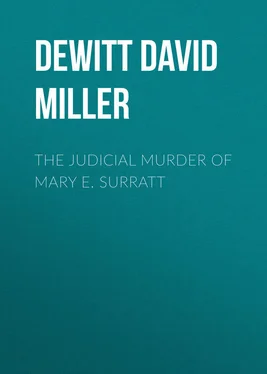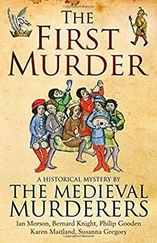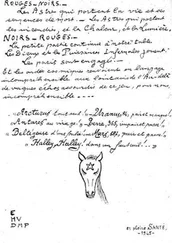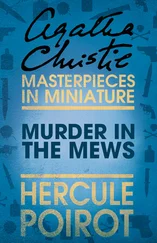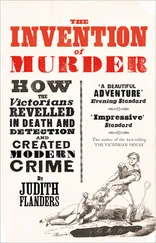David DeWitt - The Judicial Murder of Mary E. Surratt
Здесь есть возможность читать онлайн «David DeWitt - The Judicial Murder of Mary E. Surratt» — ознакомительный отрывок электронной книги совершенно бесплатно, а после прочтения отрывка купить полную версию. В некоторых случаях можно слушать аудио, скачать через торрент в формате fb2 и присутствует краткое содержание. Жанр: foreign_antique, foreign_prose, на английском языке. Описание произведения, (предисловие) а так же отзывы посетителей доступны на портале библиотеки ЛибКат.
- Название:The Judicial Murder of Mary E. Surratt
- Автор:
- Жанр:
- Год:неизвестен
- ISBN:нет данных
- Рейтинг книги:5 / 5. Голосов: 1
-
Избранное:Добавить в избранное
- Отзывы:
-
Ваша оценка:
- 100
- 1
- 2
- 3
- 4
- 5
The Judicial Murder of Mary E. Surratt: краткое содержание, описание и аннотация
Предлагаем к чтению аннотацию, описание, краткое содержание или предисловие (зависит от того, что написал сам автор книги «The Judicial Murder of Mary E. Surratt»). Если вы не нашли необходимую информацию о книге — напишите в комментариях, мы постараемся отыскать её.
The Judicial Murder of Mary E. Surratt — читать онлайн ознакомительный отрывок
Ниже представлен текст книги, разбитый по страницам. Система сохранения места последней прочитанной страницы, позволяет с удобством читать онлайн бесплатно книгу «The Judicial Murder of Mary E. Surratt», без необходимости каждый раз заново искать на чём Вы остановились. Поставьте закладку, и сможете в любой момент перейти на страницу, на которой закончили чтение.
Интервал:
Закладка:
The room in which the Commission met was in the northeast corner of the third story of the Old Penitentiary; a building standing in the U. S. Arsenal Grounds at the junction of the Potomac with the Eastern Branch, in a room on the ground floor of which the body of Booth had been secretly buried. Its windows were guarded by iron gratings, and it communicated with that part of the prison where the accused were now confined, by a door in the western wall. The male prisoners had been removed some days before from the Monitors to the Penitentiary, where Mrs. Surratt was already incarcerated, and each of them, including the lady, was now immured in a solitary cell under the surveillance of a special guard.
Around a table near the eastern side of this room sat, resplendent in full uniform, the members of the Court. At the head as President was Major-General David Hunter – a stern, white-headed soldier, sixty-three years old; a fierce radical; the first officer to organize the slaves into battalions of war; the warm personal friend of Lincoln, at the head of whose corpse he had grimly sat as it rested from place to place on the triumphal progress to its burial, and from whose open grave he had hurried, in no very judicial humor to say the least, to take his seat among the Judges of the accused assassins. On his right sat Major-General Lew Wallace, a lawyer by profession; afterwards the President of the Court-Martial which tried and hung Henry Wirz; but now, by a sardonic freak of destiny, known to all the world as the tender teller of “Ben Hur, a Tale of the Christ.” To the right of General Wallace sat Brevet Brigadier-General James A. Ekin and Brevet Colonel Charles A. Tompkins; about whom the only thing remarkable is that they had stepped into the places of the two relieved officers, Colonel Tompkins being the only regular army officer on the Board. On the left of General Hunter sat, first, Brevet Major-General August V. Kautz, a native of Germany; next, Brigadier-General Robert S. Foster, who may or may not have been the “Colonel Foster” alluded to in the testimony of Lloyd quoted above, as threatening the witness and as afterwards being seen by him on the Commission – the presence of an officer, previously engaged by the Government in collecting testimony against the accused, as one of the judges to try him not being considered a violation of Military Justice. Next sat Brigadier-General Thomas Mealey Harris, a West Virginian, and the author of a book entitled “Calvinism Vindicated;” next, Brigadier-General Albion P. Howe, and last, Lieutenant-Colonel David R. Clendenin.
Not one of these nine men could have withstood the challenge which the common law mercifully puts into the hands of the most abandoned culprit. They had come together with one determined and unchangeable purpose – to avenge the foul murder of their beloved Commander-in-Chief. They dreamt not of acquittal. They were, necessarily, from the very nature of their task, organized to convict .
The accused were asked, it is true, whether they had any objections to any member of the Court. But this was the emptiest of forms, as bias is no cause of challenge in military procedure, and peremptory challenges are unknown.
Moreover, it was nothing but a cruel mockery to offer to that trembling group of prisoners an opportunity, which, if any one of them had the temerity to embrace, could only have resulted in barbing with the sting of personal insult the hostile predisposition of the judges.
At the foot of the table around which the Court sat – the table standing parallel with the north side of the room – there was another, around which were gathered the three prosecuting officers, who, according to military procedure, were also members of the Commission.
First, was Brigadier-General Joseph Holt, the Judge-Advocate of the U. S. Army, and the Recorder of the Commission. During his past military career he had distinguished himself on many a bloody court-martial.
Second, designated by General Holt as First Assistant or Special Judge-Advocate, was Hon. John A. Bingham, of Ohio – long a Representative in Congress, then for a short interval a Military Judge-Advocate, now a Representative in Congress again, and to become in the strange vicissitudes of the near future, one of the managers of the impeachment of President Johnson, whom he now cannot praise too highly. He was one of those fierce and fiery western criminal lawyers, gifted with that sort of vociferous oratory which tells upon jurors and on the stump, by nature and training able to see but one side to a case and consequently merciless to his victims. His special function was to cross-examine and brow-beat the witnesses for the defense, a branch of his profession in which he was proudly proficient, and, above all, by pathetic appeals to their patriotism and loyalty, and by measureless denunciations of the murder of their Commander-in-Chief and of the Rebellion, to keep up at a white heat the already burning passions of the officers composing the tribunal. Next to him came Colonel Henry L. Burnett; brought from Indiana where he had won recent laurels in conducting the trial of Milligan for treason before a Military Commission – laurels, alas! soon to be blasted by the decision of the U. S. Supreme Court pronouncing that and all other Military Commissions for the trial of citizens in places where the civil courts are open illegal, and setting free the man this zealous public servant had been instrumental in condemning to death.
In the centre of the room was a witness-stand facing the Court. To the left of the witness-stand a table for the official reporters. Along the western side and directly opposite the Court was a platform about a foot high and four feet broad, with a strong railing in front of it. This was the prisoners’ dock. The platform was divided near the left hand or southern corner by the doorway which led to the cells. In front of the southern end of the dock and behind the witness-stand was the table of the prisoners’ counsel.
At the appointed hour the door in the western side opens and an impressive and mournful procession appears. Six soldiers armed to the teeth are interspersed among seven male prisoners and one woman.
First walks Samuel Arnold, the young Baltimorean, who is to sit at the extreme right ( i. e. , of the spectators), followed close by his armed guard; next, Dr. Samuel T. Mudd and a soldier; next, Edward Spangler and a soldier; next, Michael O’Laughlin, another Baltimorean, and his soldier; next, George B. Atzerodt and a soldier; next, Lewis Payne, a tall gladiator, though only twenty years old, and his soldier; and then David E. Herold, looking like an insignificant boy, who is to sit next the door. As they enter, their fetters clanking at every step, they turn to their left and take seats on the platform in the order named, the six soldiers being sandwiched here and there between two of the men.
Each of these prisoners, during the entire trial, was loaded down with irons made as massive and uncomfortable as possible. Their wrists were bound with the heaviest hand-cuffs, connected by bars of iron ten inches long (with the exception of Dr. Mudd, whose hand-cuffs were connected by a chain), so that they could not join their hands. Their legs were weighed down by shackles joined by chains made short enough to hamper their walk. In addition to these fetters, common to all, Payne and Atzerodt had, attached by chains to their legs, huge iron balls, which their guards had to lift and carry after them whenever they entered or left the Court room.
Last, there emerges from the dungeon-like darkness of the doorway the single female prisoner, Mary E. Surratt. She, alone, turns to her right and, consequently, when she is seated has the left hand corner of the platform to herself. But she is separated from her companions in misery by more than the narrow passage-way that divides the dock; for she is a lady of fair social position, of unblemished character and of exemplary piety, and, besides, she is a mother, a widow, and, in that room amongst all those soldiers, lawyers, guards, judges and prisoners, the sole representative of her sex. Her womanhood is her peculiar weakness, yet still her only shield.
Читать дальшеИнтервал:
Закладка:
Похожие книги на «The Judicial Murder of Mary E. Surratt»
Представляем Вашему вниманию похожие книги на «The Judicial Murder of Mary E. Surratt» списком для выбора. Мы отобрали схожую по названию и смыслу литературу в надежде предоставить читателям больше вариантов отыскать новые, интересные, ещё непрочитанные произведения.
Обсуждение, отзывы о книге «The Judicial Murder of Mary E. Surratt» и просто собственные мнения читателей. Оставьте ваши комментарии, напишите, что Вы думаете о произведении, его смысле или главных героях. Укажите что конкретно понравилось, а что нет, и почему Вы так считаете.
